tire size JEEP WRANGLER 2008 Owners Manual
[x] Cancel search | Manufacturer: JEEP, Model Year: 2008, Model line: WRANGLER, Model: JEEP WRANGLER 2008Pages: 466, PDF Size: 8.61 MB
Page 63 of 466
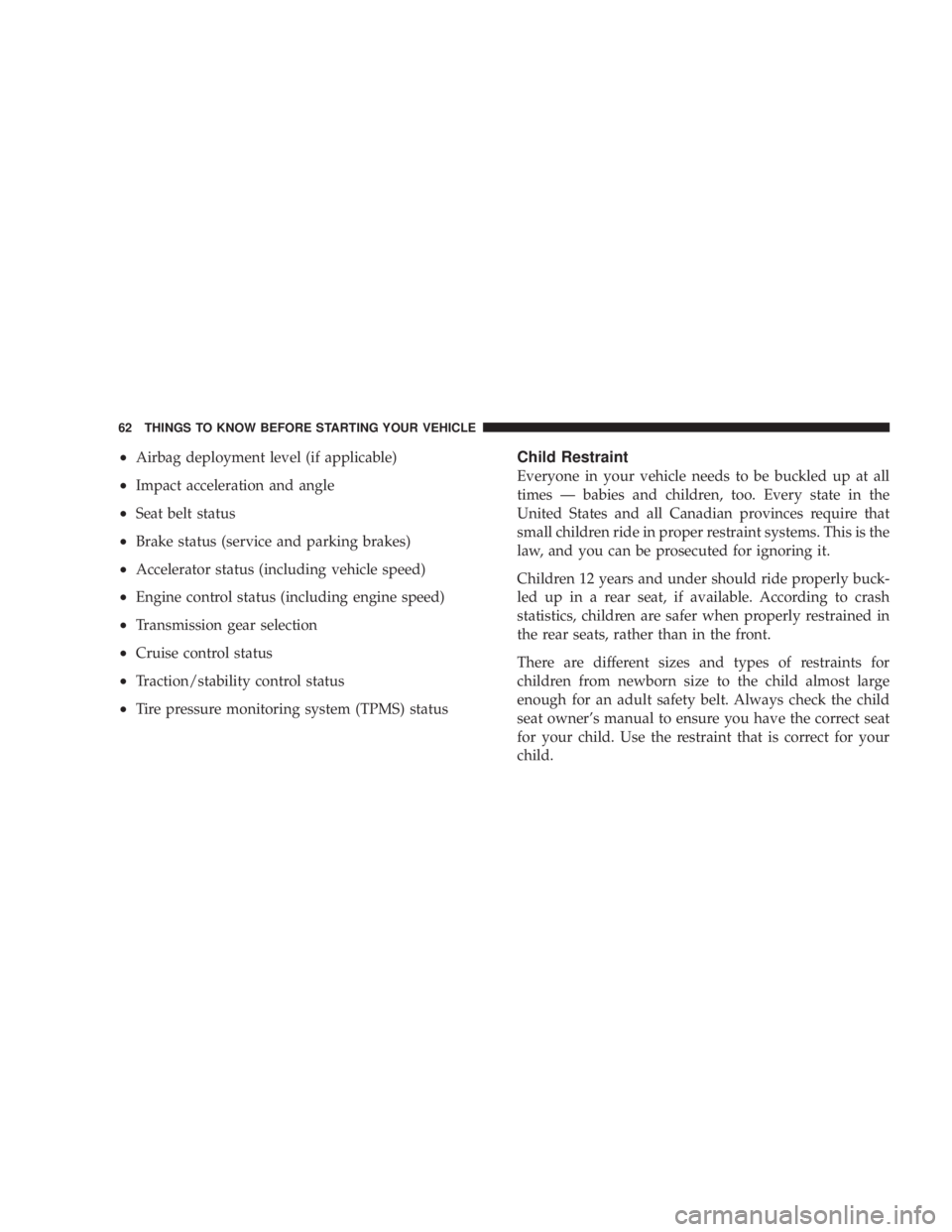
•Airbag deployment level (if applicable)
•Impact acceleration and angle
•Seat belt status
•Brake status (service and parking brakes)
•Accelerator status (including vehicle speed)
•Engine control status (including engine speed)
•Transmission gear selection
•Cruise control status
•Traction/stability control status
•Tire pressure monitoring system (TPMS) status
Child Restraint
Everyone in your vehicle needs to be buckled up at all
times — babies and children, too. Every state in the
United States and all Canadian provinces require that
small children ride in proper restraint systems. This is the
law, and you can be prosecuted for ignoring it.
Children 12 years and under should ride properly buck-
led up in a rear seat, if available. According to crash
statistics, children are safer when properly restrained in
the rear seats, rather than in the front.
There are different sizes and types of restraints for
children from newborn size to the child almost large
enough for an adult safety belt. Always check the child
seat owner’s manual to ensure you have the correct seat
for your child. Use the restraint that is correct for your
child.
62 THINGS TO KNOW BEFORE STARTING YOUR VEHICLE
Page 211 of 466

21. Odometer/Trip Odometer Reset Button
Press this button to change the display from odometer to
either of two trip odometer settings. Trip A or Trip B will
appear when in the trip odometer mode. Press and hold
the button for two seconds to reset the trip odometer to 0
miles or kilometers. The odometer must be in trip mode
to reset.
22. Transmission Range Indicator
This display indicator shows the automatic transmission
gear selection.
23. Tire Pressure Monitoring Telltale LightEach tire, including the spare (if provided),
should be checked monthly when cold and
inflated to the inflation pressure recommended
by the vehicle manufacturer on the vehicle
placard or tire inflation pressure label. (If your vehicle
has tires of a different size than the size indicated on the vehicle placard or tire inflation pressure label, you should
determine the proper tire inflation pressure for those
tires.)
As an added safety feature, your vehicle has been
equipped with a tire pressure monitoring system (TPMS)
that illuminates a low tire pressure telltale when one or
more of your tires is significantly under-inflated. Accord-
ingly, when the low tire pressure telltale illuminates, you
should stop and check your tires as soon as possible, and
inflate them to the proper pressure. Driving on a signifi-
cantly under-inflated tire causes the tire to overheat and
can lead to tire failure. Under-inflation also reduces fuel
efficiency and tire tread life, and may affect the vehicle’s
handling and stopping ability.
Please note that the TPMS is not a substitute for proper
tire maintenance, and it is the driver ’s responsibility to
maintain correct tire pressure, even if under-inflation has
not reached the level to trigger illumination of the TPMS
low tire pressure telltale.
Page 287 of 466

rear wheels to rotate at the same speed. This is accom-
plished by simply moving the shift lever to one of these
positions. The 4H and 4L positions are intended for loose,
slippery road surfaces only, and not intended for normal
driving. Driving in the 4H and 4L positions on hard
surfaced roads will cause increased tire wear and damage
to the driveline components.
The 4WD Indicator Light (located in the instrument
cluster) alerts the driver that the vehicle is in four-wheel
drive, and the front and rear driveshafts are locked
together. The light will illuminate when the transfer case
is shifted into the 4H position.
NOTE:Do not attempt to shift when only the front or
rear wheels are spinning. The transfer case is not
equipped with a synchronizer, and the front and rear
driveshaft speeds must be equal for a shift to take place.
Shifting while only the front or rear wheels are spinning
can cause damage to the transfer case. When operating your vehicle in 4L, the engine speed will
be approximately three times (four times for Rubicon
models) that of the 2H or 4H positions at a given road
speed. Take care not to overspeed the engine.
Proper operation of four-wheel drive vehicles depends
on tires of equal size, type, and circumference on each
wheel. Any difference will adversely affect shifting and
cause damage to the transfer case.
Because four-wheel drive provides improved traction,
there is a tendency to exceed safe turning and stopping
speeds. Do not go faster than road conditions permit.
286 STARTING AND OPERATING
Page 311 of 466
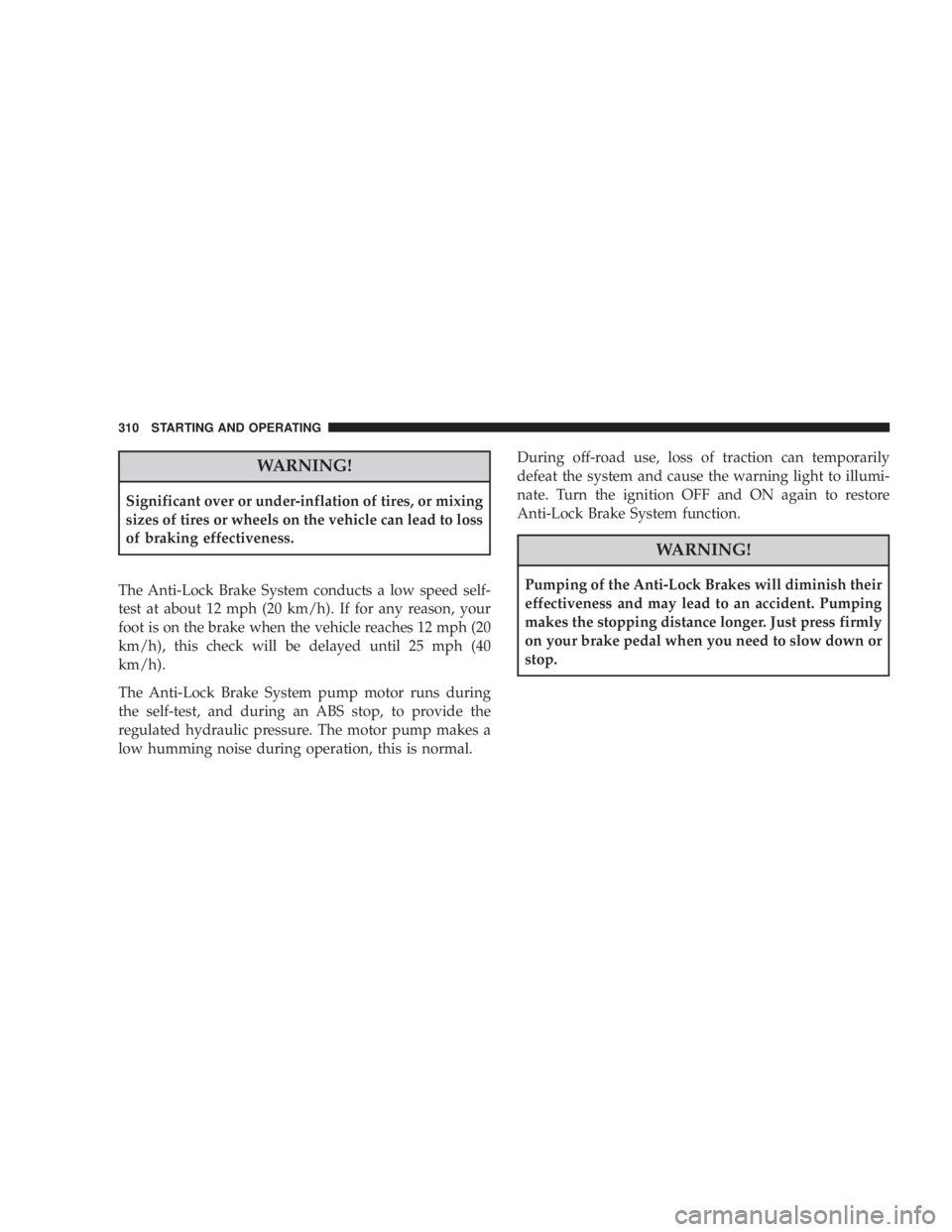
WARNING!
Significant over or under-inflation of tires, or mixing
sizes of tires or wheels on the vehicle can lead to loss
of braking effectiveness.
The Anti-Lock Brake System conducts a low speed self-
test at about 12 mph (20 km/h). If for any reason, your
foot is on the brake when the vehicle reaches 12 mph (20
km/h), this check will be delayed until 25 mph (40
km/h).
The Anti-Lock Brake System pump motor runs during
the self-test, and during an ABS stop, to provide the
regulated hydraulic pressure. The motor pump makes a
low humming noise during operation, this is normal. During off-road use, loss of traction can temporarily
defeat the system and cause the warning light to illumi-
nate. Turn the ignition OFF and ON again to restore
Anti-Lock Brake System function.
Page 319 of 466
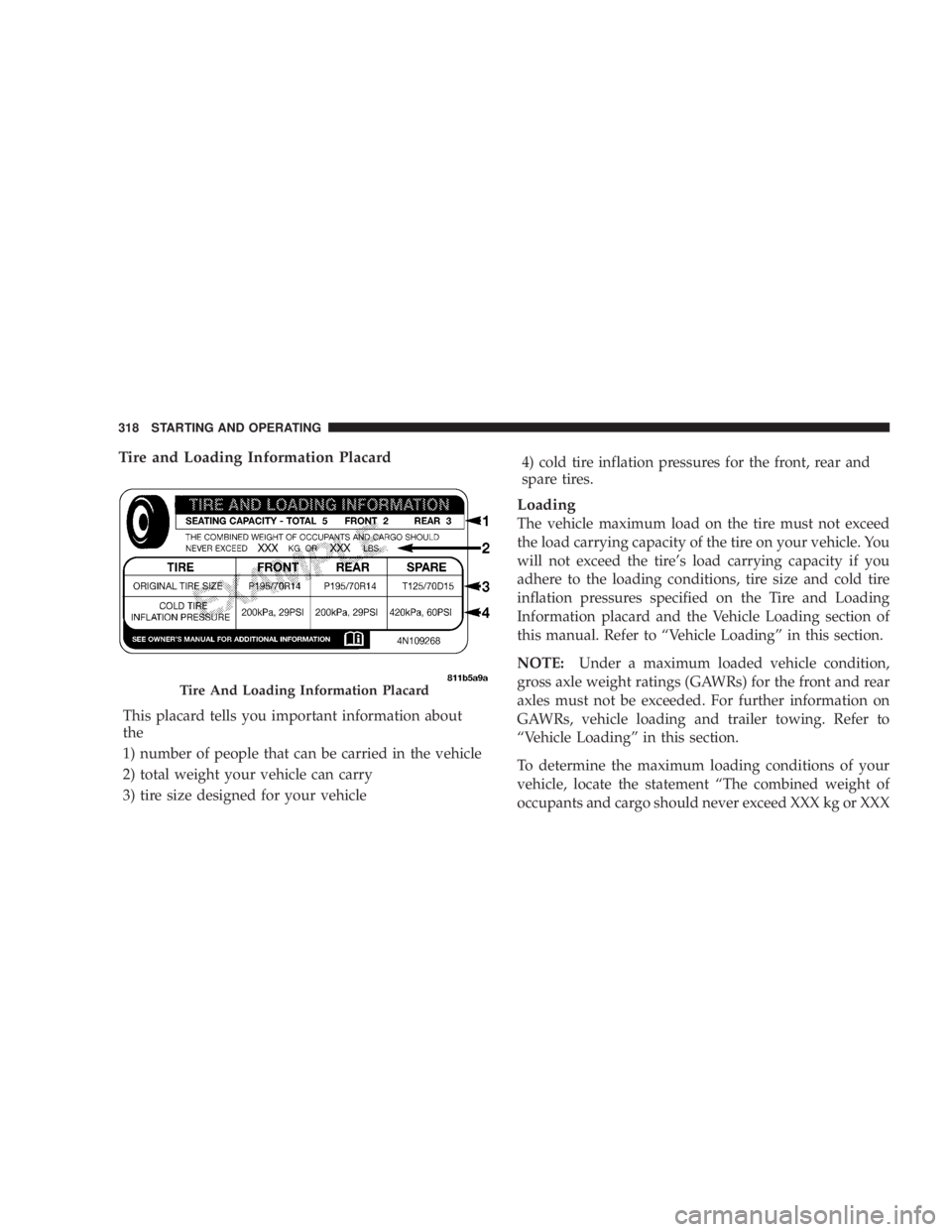
Tire and Loading Information Placard
This placard tells you important information about
the
1) number of people that can be carried in the vehicle
2) total weight your vehicle can carry
3) tire size designed for your vehicle4) cold tire inflation pressures for the front, rear and
spare tires.
Loading
The vehicle maximum load on the tire must not exceed
the load carrying capacity of the tire on your vehicle. You
will not exceed the tire’s load carrying capacity if you
adhere to the loading conditions, tire size and cold tire
inflation pressures specified on the Tire and Loading
Information placard and the Vehicle Loading section of
this manual. Refer to “Vehicle Loading” in this section.
NOTE:
Under a maximum loaded vehicle condition,
gross axle weight ratings (GAWRs) for the front and rear
axles must not be exceeded. For further information on
GAWRs, vehicle loading and trailer towing. Refer to
“Vehicle Loading” in this section.
To determine the maximum loading conditions of your
vehicle, locate the statement “The combined weight of
occupants and cargo should never exceed XXX kg or XXX
Page 329 of 466

WARNING!
•Do not use a tire, wheel size or rating other than that
specified for your vehicle. Some combinations of
unapproved tires and wheels may change suspension
dimensions and performance characteristics, result-
ing in changes to steering, handling, and braking of
your vehicle. This can cause unpredictable handling
and stress to steering and suspension components.
You could lose control and have an accident resulting
in serious injury or death. Use only the tire and wheel
sizes with load ratings approved for your vehicle.
• Never use a tire with a smaller load index or capacity,
other than what was originally equipped on your
vehicle. Using a tire with a smaller load index could
result in tire overloading and failure. You could lose
control and have an accident.
• Failure to equip your vehicle with tires having ad-
equate speed capability can result in sudden tire
failure and loss of vehicle control.
Page 333 of 466
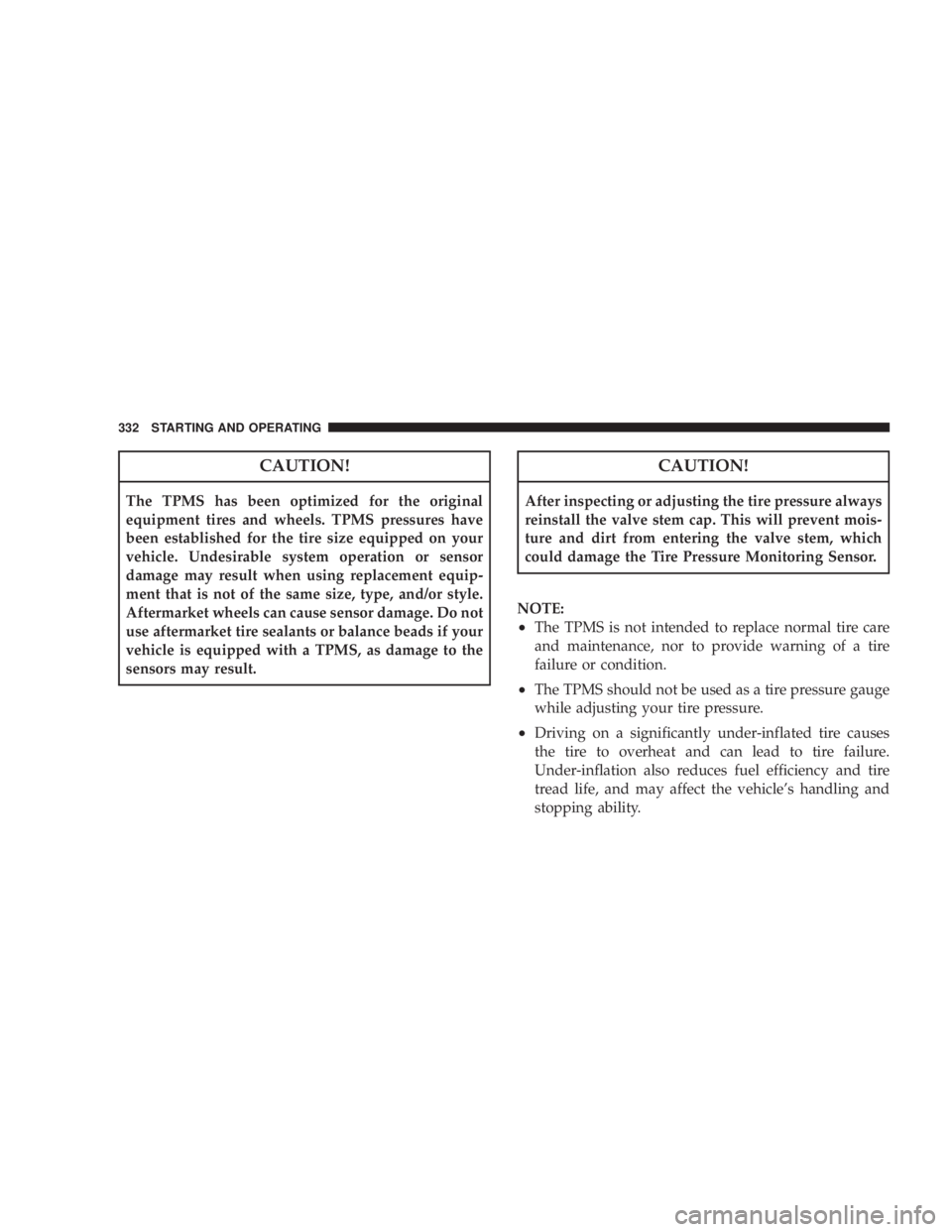
CAUTION!
The TPMS has been optimized for the original
equipment tires and wheels. TPMS pressures have
been established for the tire size equipped on your
vehicle. Undesirable system operation or sensor
damage may result when using replacement equip-
ment that is not of the same size, type, and/or style.
Aftermarket wheels can cause sensor damage. Do not
use aftermarket tire sealants or balance beads if your
vehicle is equipped with a TPMS, as damage to the
sensors may result.
Page 335 of 466
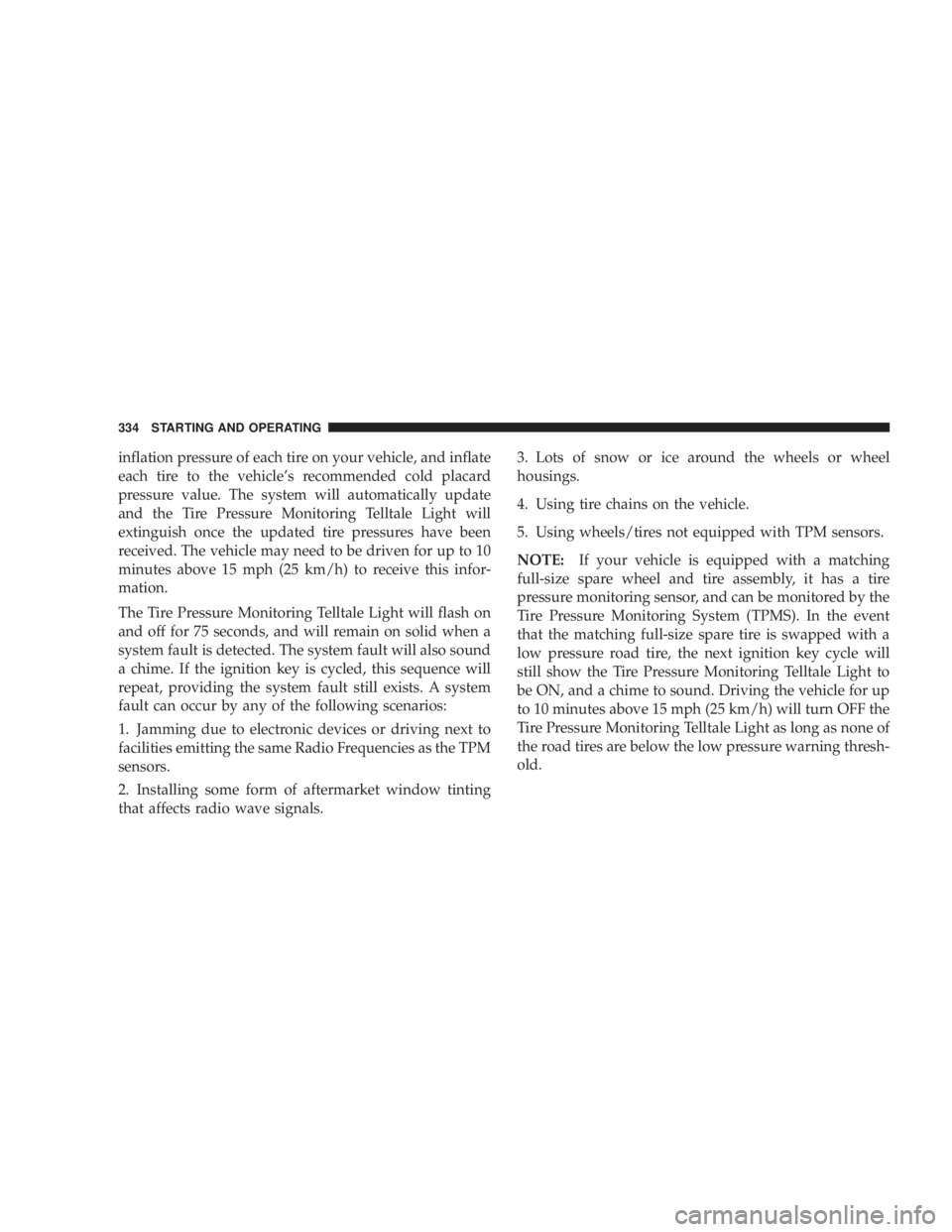
inflation pressure of each tire on your vehicle, and inflate
each tire to the vehicle’s recommended cold placard
pressure value. The system will automatically update
and the Tire Pressure Monitoring Telltale Light will
extinguish once the updated tire pressures have been
received. The vehicle may need to be driven for up to 10
minutes above 15 mph (25 km/h) to receive this infor-
mation.
The Tire Pressure Monitoring Telltale Light will flash on
and off for 75 seconds, and will remain on solid when a
system fault is detected. The system fault will also sound
a chime. If the ignition key is cycled, this sequence will
repeat, providing the system fault still exists. A system
fault can occur by any of the following scenarios:
1. Jamming due to electronic devices or driving next to
facilities emitting the same Radio Frequencies as the TPM
sensors.
2. Installing some form of aftermarket window tinting
that affects radio wave signals.3. Lots of snow or ice around the wheels or wheel
housings.
4. Using tire chains on the vehicle.
5. Using wheels/tires not equipped with TPM sensors.
NOTE:
If your vehicle is equipped with a matching
full-size spare wheel and tire assembly, it has a tire
pressure monitoring sensor, and can be monitored by the
Tire Pressure Monitoring System (TPMS). In the event
that the matching full-size spare tire is swapped with a
low pressure road tire, the next ignition key cycle will
still show the Tire Pressure Monitoring Telltale Light to
be ON, and a chime to sound. Driving the vehicle for up
to 10 minutes above 15 mph (25 km/h) will turn OFF the
Tire Pressure Monitoring Telltale Light as long as none of
the road tires are below the low pressure warning thresh-
old.
334 STARTING AND OPERATING
Page 461 of 466

Storage, Vehicle...................... 266,419
Storing Your Vehicle ...................... 419
Sunrider ........................... 161,164
Supplemental Restraint System - Airbag ........ 51
Sway Bar Disconnect, Electronic ............. 292
Swing Gate, Rear ......................... 38
System, Navigation ...................... 250
System, Remote Starting .................... 25
Tachometer ............................ 209
Temperature Gauge, Engine Coolant .......... 209
Tether Anchor, Child Restraint ............... 68
Theft System Arming ...................... 18
Theft System Disarming .................... 18
Tilt Steering Column ..................... 101
Tip Start .............................. 272
Tire and Loading Information Placard ......317,318
Tire Identification Number (TIN) ............. 316
Tire Markings .......................... 313 Tire Safety Information
.................... 313
Tires .............................. 321,442
Air Pressure .......................... 322
Alignment and Balance .................. 328
Chains .............................. 329
Changing ............................ 366
General Information .................... 321
High Speed .......................... 324
Inflation Pressures ..................... 322
Jacking ........................... 366,369
Load Capacity ..................... 317,318
Pressure Monitor System (TPMS) ........... 330
Pressure Warning Light .................. 210
Quality Grading ....................... 442
Radial .............................. 325
Replacement ......................... 327
Rotation ............................. 329
Safety .............................. 313
Sizes ............................... 314
460 INDEX